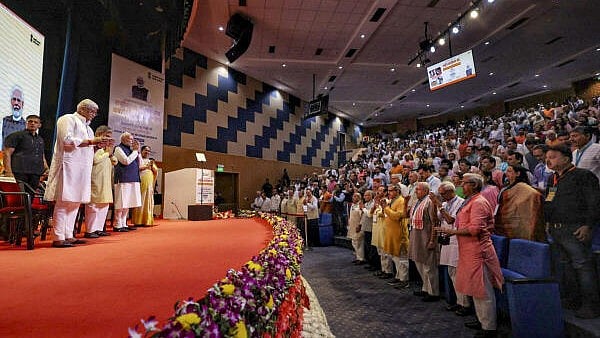
Prime Minister Narendra Modi during the centenary celebrations of the Rashtriya Swayamsevak Sangh (RSS).
Credit: PTI
The Rashtriya Swayamsevak Sangh (RSS), which is set to complete 100 years on Thursday, has come a long way since its inception to become the largest socio-cultural organisation.
Here is a timeline of key events that shaped the RSS' journey, including the various highs and lows:
1925
Dr Keshav Baliram Hedgewar announced the launch of the Sangh on September 27.
1926
The organisation got its name, the Rashtriya Swayamsevak Sangh, on April 17 after a majority of a small group of Hedgewar's followers voted in its favour out of a total of four proposed names.
1926
First Nitya Shakha started at Mohitewada ground in Nagpur on May 28.
1927
First special training camp with the name O.T.C. - officer's training camp - held in May with 17 participants
1928
First ceremony of initiation, Pratignya, was conducted in March. A selected group of 99 Swayamsevaks participated.
1929
Dr Keshav Baliram Hedgewar was designated as RSS Sarsanghachalak(guide and mentor], Balaji Huddar as Sarkaryavah (general secretary) and Martandrao Jog as Sarsenapati(chief instructor) at a two-day meeting in November.
1930
Congress passed a resolution proclaiming Purna Swaraj. Hedgewar instructed all Shakhas to celebrate 26 January as Independence Day.
Hedgewar, along with several swayamsevaks, participated in Jungle Satyagraha, arrested. The black cap was introduced as part of the RSS 'ganvesh' (uniform) in place of the Khaki cap.
1940
The British government banned the Sangh uniform and route march.
Sanskrit prarthna (prayer) was introduced in place of Hindi and Marathi prarthna. Sanskrit 'ajnas' (instructions) were introduced in place of English instructions. Hedgewar passed away on June 21. Madhav Sadasiva Golwalkar, fondly called as Guruji, was designated as the second RSS Sarsanghchalak on July 3.
1947
RSS swayamsevaks started 'Bharatiya Swayamsevak Sangh' in Kenya. 'Organiser' and 'Panchajanya' weeklies were launched.
1948
RSS was banned after Mahatma Gandhi's assassination on January 30. Then RSS chief Madhav Sadasiva Golwalkar and thousands of swayamsevaks arrested.
1949
The government lifted the ban on July 12, 1949. Sangh's constitution was drafted. Akhil Bharatiya Vidyardhi Parishad (ABVP) was launched.
1950
The first Akhil Bharatiya Pratinidhi Sabha, meeting of the RSS' highest decision-making body, was held in March. Vastuhara Sahayata Samiti was started to help Hindu refugees from Pakistan.
1952
A nationwide Goraksha Andolan (cow protection movement) was launched, demanding the prohibition of cow slaughter in the country. The Vanvasi Kalyan Ashram was launched. Bharatiya Jansangh was formed by Dr Syama Prasad Mookerjee and many Swayamsevaks joined it.
1954
Swayamsevaks participated in the liberation of Dadra and Nagar Haveli from Portuguese control on August 2.
1955
Swayamsevaks took a leading part in the all-party struggle for the liberation of Goa from the control of the Portuguese. Bharatiya Mazdoor Sangh was founded.
1963
As many as 3000 RSS swayamsevaks participated in the Republic Day Parade on January 26 in Delhi in full uniform and band after it got an invite.
1964
Vishva Hindu Parishad (VHP) was launched.
1973
Madhav Sadasiva Golwalkar passed away on June 5. Madhukar Dattatraya Deoras, popularly known as Balasaheb Deoras, was designated as the RSS Sarsanghchalak on June 6.
1975
The Indira Gandhi government imposed the Emergency on June 25. RSS was banned for the second time on July 4. Balasaheb arrested. Akhil Bharatiya Lok Sangharshana Samiti was launched to fight against the Emergency.
1977
Bharatiya Jana Sangh merged into the newly formed Janata Party, which came to power. The government lifted the ban on the Sangh on March 22. Jayprakash Narayan addresses the RSS meeting in Patna on November 3.
1978
Deen Dayal Sodh Sanstan launched.
1980
The Bharatiya Janata Party (BJP) was formed.
1981
Sanskar Bharati was founded.
1992
The Centre bans the RSS on December 10 after the demolition of the Babri mosque in Ayodhya.
1993
The Bahri Tribunal finds the ban on the Sangh unjustified and lifts it on June 4. Akhil Bharatiya Poorva Sainik Seva Parishad was founded.
1994
Rajendra Singh, popularly known as Rajju Bhayya, was designated as the RSS' fourth Sarsanghchalak on March 11. Laghu Udyog Bharati was founded.
1998
The BJP-led National Democratic Alliance (NDA) forms the government at the Centre, with Atal Bihari Vajpayee, a former RSS Pracharak, as prime minister.
2000
K S Sudershan was designated as the RSS' fifth Sarsanghchalak on March 11.
2009
KS Sudershan named Dr Mohan Bhagwat as the next Sarsanghchalak of the Sangh. Suresh Bhaiyyaji Joshi elected as the Sarkaryavah of the Sangh.
2016
RSS replaced khaki shorts with brown trousers for Swayamsevaks uniform signifying the organisation's intent to change with times and adopt dress codes in which younger generations feel comfortable.
2021
Dattatreya Hosabale elected as the RSS Sarkaryavah.